Libraries Unlimited Gender Pay Gap as at April 2020
- Executive Summary
On 5th April 2020 Libraries Unlimited had 417 roles with 346 filled by women (83%) and 71 filled by men (17%). As Libraries Unlimited does not have a bonus scheme, the percentage difference between men and women’s bonuses was zero.
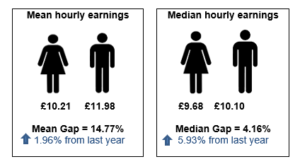
Libraries Unlimited’s Gender Pay Gap is largely a result of our workforce being predominantly women (which we know from our colleagues is a trend across the library sector) but that being more pronounced in the lower quartiles. There are more women at all levels of the organisation, but significantly fewer men in the lower and lower middle quartiles (22% across both compared to 24% in the upper quartile alone).
Libraries Unlimited’s GPG is also affected by a high number of employees working part time who are more likely to be paid a lower hourly median pay than full time workers[1]. It is argued that this is because traditionally part-time roles are less senior and therefore are paid less, with a legacy perspective that lower paid roles can be performed part time more easily; and that women have been more likely to take part time roles to fit around caring responsibilities. 67% of our workforce are part-time women, but only 11% are part time men.
The age of our workforce also impacts our GPG. 82% of Libraries Unlimited employees are 40+ of which National Statistics1 show that the GPG increases by around 10% for people over 40.
Another factor which effects our GPG is relief contracts. 29% of Libraries Unlimited’s roles are relief of which 81% are women and 81% are paid within the lower quartile. As these roles are flexible, they can be more easily managed around caring responsibilities and therefore may be more attractive to women who continue to take on a significantly higher share of the caring. If we exclude relief roles our median GPG reduces by 1.88%.
Our median GPG is 4.16% which highlights a greater level of overall equality and is significantly less than the ONS national average of 15.5%. Compared to other Library Services, our GPG is similar or better.
We are committed to equality and diversity and to being a fair, open, and honest employer, and we will continue to identify ways in which we can minimise the Gender Pay Gap. We want to create greater diversity in our staff across the whole organisation to better represent the communities that we serve. In particular, we want to encourage more men into frontline roles, women into senior roles in all areas of the organisation especially traditionally male dominated sectors, and men to utilise flexible working and family friendly policies such as Shared Parental Leave.
- Introduction
As an organisation with more than 250 employees, we are legally required to comply with the Equality Act 2010 (Specific Duties and Public Authorities) Regulations 2017 and publish Gender Pay Gap reporting information on an annual basis.
The Gender Pay Gap (GPG) is defined as the difference between the mean and median hourly rate of pay that men and women receive. It is not a measure of the difference in pay between men and women for doing the same job.
The mean pay gap is the difference between average hourly earnings of men and women.
The median pay gap is the difference between the mid points in the ranges of hourly earnings of men and women. It takes all salaries in the sample, lines them up in order from lowest to highest, and picks the middle-most salary.
- Our Gender Pay Gap results
On 5th April 2020 Libraries Unlimited had 417 roles with 346 filled by women (83%) and 71 filled by men (17%). As per reporting rules, any staff with unpaid periods are not included. It is also important to note that one of the senior roles (Head of Service Delivery, now Head of Library Service and Customer Experience) was a vacant post at this point.
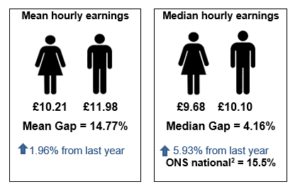
This means men were paid either 4.16% (median) or 14.77% (mean) more than women.
In looking at our full time[3] employees only, men were paid even higher at 12.31% (median) than women.
Libraries Unlimited does not pay bonuses to any staff; therefore, the further three statutory calculations of the mean bonus Gender Pay Gap, the median bonus Gender Pay Gap and the proportion of men and women receiving a bonus payment are not applicable.
- Analysis
Libraries Unlimited’s Gender Pay Gap is largely a result of our workforce being predominantly women, which we know from our colleagues is a trend across the library sector but that being more pronounced in the lower quartiles. There are more women at all levels of the organisation, but significantly fewer men in the lower and lower middle quartiles (22% across both) and most in the upper quartile (24%). Overall, the percentage of roles filled by men has increased by 2% compared to 2019, however they have increased in the top two quartiles which has accentuated the pay gap.
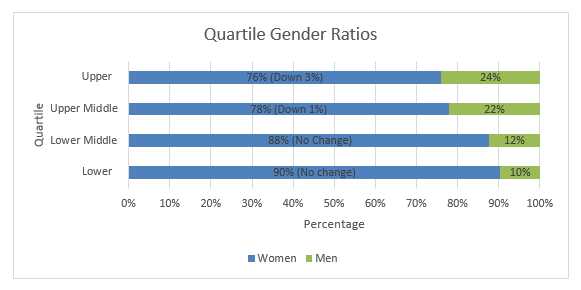
In addition to calculating the statistics that are legally required, Libraries Unlimited has done some further analysis to aid understanding of its Gender Pay Gap.
The following graph shows that Libraries Unlimited has significantly more women than men on hourly rates between £8.00 – £14.99. The ratios of men and women from an hourly rate of £15.00 upwards is relatively even. In the upper quartile there are 7 roles with an hourly rate of £20+ and 57% of those are men (as above the Head of Library Service and Customer Experience was vacant at this point). This indicates that our GPG is primarily caused by large proportions of women in lower hourly rate posts, rather than male dominance in senior roles.
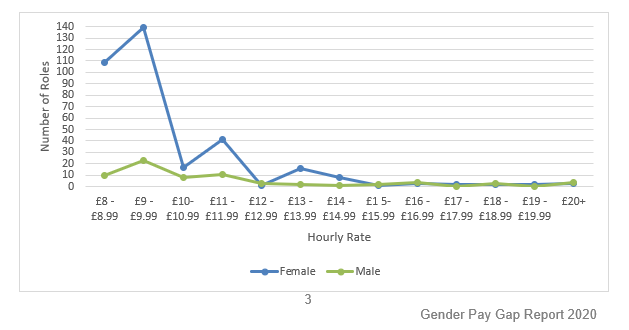
It is believed that the reasons for female dominance in the lower paid posts are consistent with what has been found by the ONS, specifically a higher proportion of lower paid roles can be performed part-time, as many of our roles are, and in particular the specific flexibility of relief contracts, which is commonly attractive to women as it is compatible with their personal circumstances, such as caring responsibilities which women are more likely to have than men.
4(a). Part time working
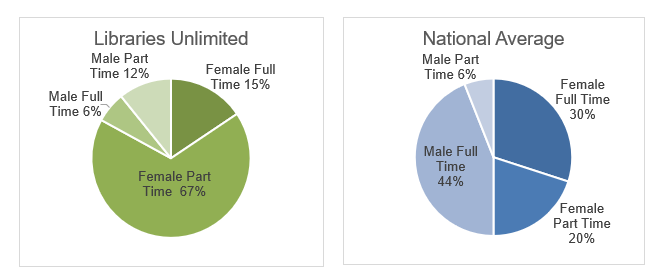
ONS report that around 6% of men work part time compared to around 20% of women[4]. National statistics also show that part time workers (male and female) are paid a lower hourly median pay than full time workers[5]. It is argued that this is because traditionally part-time roles are less senior and therefore are paid less, with a legacy perspective that lower paid roles can be performed part time more easily. Libraries Unlimited’s GPG is therefore slightly affected by the fact that 67% of the workforce are part-time women, but only 11% are part time men.
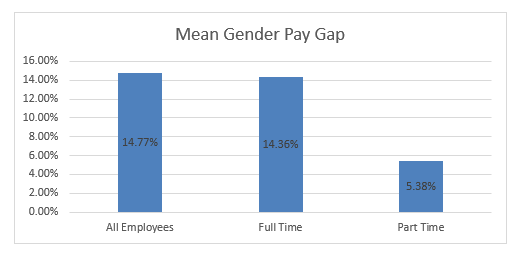
The mean gender pay gap for full time employees is 14.36% which means women earn 14.36% less than men. Including part time employees, this increases slightly to 14.77%, confirming that part time working does slightly influence our GPG. Whilst there is a smaller gender pay gap for part time employees, the average part time women’s pay is much lower than that of their full-time colleagues, by around £3.62 per hour.
Our part time women’s pay gap which is a comparison of women’s part time average hourly rate to men’s full time average hourly rate is 37.99%. This means part time women within our organisation are paid 37.99% less than full time men.
4(b). Age of staff
National Statistics[6] show that the GPG increases by around 10% for people over 40. Analysis suggests that there is a lower incidence of women moving into higher- paid occupations after the age of 39 and it is speculated that the GPG increases due to more women taking time out of work and working part time to have and care for children and/or elderly relatives.

This indicates that the age of our workforce impacts on our GPG.
4(c). Relief contracts
A large proportion (29%) of Libraries Unlimited’s roles are relief roles of which 81% are women and a majority (81%) are paid within the lower quartile. If we were to look at Libraries Unlimited’s fixed hours only roles, therefore exclude the relief roles, our median Gender Pay Gap would be 2.28% which is a reduction by 1.88% of all roles. Therefore, this suggests that our GPG is affected by the amount of relief roles we have. As these roles are flexible, they can be more easily managed around caring responsibilities and therefore may be more attractive to women, as set out above.
4(d). GPG across different teams
Support/office teams made up only 6.2% of all our roles – this includes the following small teams, all with a manager; Finance, IT, HR, Marketing & Fundraising, Premises, Evolve, Volunteering and Executive. 88% of our support roles fall in the Upper Middle and Upper quartiles, compared to 50% for our Service Delivery roles. Men make up 58% of the support roles, with 73% falling in the Upper quartile.
The GPG for our support teams is 24.12% (median) and 15.18% (mean). This is considerably higher than our service delivery teams which have a GPG of 7.19% (median) and 4.02% (mean).
The reason the GPG may be higher for the support roles is because they are specialisms which tend to be dominated by men, such as IT, Finance and Executive. As per ONS findings women hold only 20% of IT roles, 47% of Finance roles and 35% Chief Exec & Senior roles.[7] This is representative within our organisation with women holding only 14% of IT role, 25% of Finance roles and 33% of Chief Exec & Executive roles at this time. It is worth noting again that as of 5 April 2020 the Head of Service Delivery was a vacant post, it was filled by a woman and is again currently filled by a woman, therefore this would affect these results.
Our service delivery team have a lower GPG which indicates that we are providing better progression for women through our service delivery roles, which we also have examples of anecdotally as well. With the support teams, there is less opportunity for progression because they are smaller teams with less routes to do this.
- External comparisons
As Gender Pay Gaps are affected by gender ratios of support staff, part time ratios and age demographics we need to be careful when making external comparisons.
Our median GPG is 4.16% which highlights a greater level of overall equality and is significantly less than the ONS national average of 15.5%. Compared to other Library Services such as Suffolk’s Libraries Limited, our median is 4.74% less and our mean is 0.93% less[8]. This suggests that within a similar sector our GPG is favourable. Our GPG is also very similar to “Library clerks and Assistants” (as reported in the ONS figures) which a makes up most of our workforce.
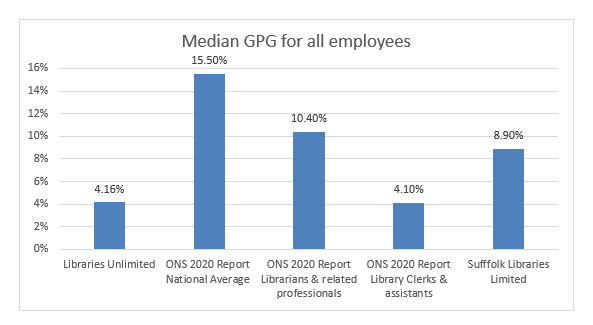
- Reducing the Gender Pay Gap
We recognise that a disproportionate number of roles in our organisation are occupied by woman, a majority of which are part time roles. We are committed to equality and diversity and to being a fair, open, and honest employer, and we will continue to identify ways in which we can minimise the Gender Pay Gap. We want to create greater diversity in our staff across the whole organisation to better represent the communities that we serve. In particular, we want to encourage more men into frontline roles, women into senior roles in all areas of the organisation especially traditionally male dominated sectors, and men to utilise flexible working and family friendly policies such as Shared Parental Leave.
Our actions include;
- Reviewing our current recruitment practices to ensure that we are targeting less well represented groups such as men within the lower paid roles and within our Service Delivery teams, and women in the senior support roles. This will include:
- Working to embed diversity, inclusion, and accessibility into all stages of our recruitment process.
- Undertaking a review of job descriptions/adverts and the language within them to highlight and change any unintentional gendered language.
- Recognising, and challenging unconscious bias throughout the selection process.
- Building more substantial posts to be attractive to a wider range of people through things like combining roles as vacancies come up (including roles across different locations).
- Promoting the flexibility of our relief roles to all members of the community who may be attracted by that flexibility, such as students, self-employed individuals with their own businesses or part time workers who want additional income and in particular men so that our relief roles are more representative of the communities we support.
- Promoting workplace flexibility for both men and women in roles where possible, such as hybrid working (home and office based), job sharing or compressed hours. Also encouraging men to work flexibly so that it is not seen as only a female benefit.
- Promoting our family friendly policies to ensure that women can progress if they have caring responsibilities and to encourage men to take on the primary carer role where they want to do that. Also embed a culture where our family friendly policies are not only offered but are normalised into smarter working practices. As an organisation we provide Maternity Pay that is more generous than the statutory minimum, like 63.5% of other organisations (36.5% do not offer enhanced maternity pay).[9] We also provide enhanced Shared Parental Leave pay, which only a quarter of organisations offer.[10] Our Shared Parental Leave pay is enhanced at the same rate as our Maternity Pay which supports a government initiative identified to address GPG.[11]
- Providing apprenticeships and training opportunities for career development and maintaining our level of internal progression, enabling employees to realise their full potential. Also, more Level 2 and Level 3 apprenticeships may result in more diversity in the lower paid roles as they may be more attractive to a wider range of people who will then get a good start in their career.
- Ensuring all employees undertake the E-learning Equality, Diversity and Inclusion training, and consider how to embed this in their working practices so that everyone feels welcomed and support when appointed so they are committed and likely to stay.
- Continuing to record recruitment statistics to analyse gender ratios of applicants through recruitment stages, so that we can gain a better understanding of where ratio disparity occurs.
Our full results are:
Quartile Gender Ratios
| Quartile | Female | Male |
|---|---|---|
| Lower | 90% | 10% |
| Lower Middle | 88% | 12% |
| Upper Middle | 88% | 12% |
| Upper | 88% | 12% |
Hourly Rate Breakdown
| Female | Male | |
|---|---|---|
| £8-£8.99 | 109 | 10 |
| £9-£9.99 | 139 | 23 |
| £10-£10.99 | 17 | 8 |
| £11-£11.99 | 41 | 11 |
| £12-£12.99 | 1 | 3 |
| £13-£13.99 | 16 | 2 |
| £14-£14.99 | 8 | 1 |
| £15-£15.99 | 1 | 2 |
| £16-£16.99 | 3 | 4 |
| £17-£17.99 | 2 | 0 |
| £18-£18.99 | 2 | 3 |
| £19-£19.99 | 2 | 0 |
| £20+ | 3 | 4 |
Libraries Unlimited Part Time
| Female | Male | |
|---|---|---|
| Part time | 67% | 12% |
| Full time | 15% | 6% |
National Average Part Time Working
| Female | Male | |
|---|---|---|
| Part time | 20% | 6% |
| Full time | 30% | 44% |
Mean Gender Pay Gap Part Time Working
| All employees | 14.77% |
| Full time employees | 14.36% |
| Part time employees | 5.38% |
Median GPG for all employees – comparison
| Libraries Unlimited | 4.16% |
| ONS 2020 Report National Average | 15.50% |
| ONS 2020 Report Librarians & related professional | 10.40% |
| ONS 2020 Report Library clerks & assistants | 4.10% |
| Suffolk Libraries Limited | 8.90% |
[1]https://www.ons.gov.uk/employmentandlabourmarket/peopleinwork/earningsandworkinghours/bulletins/genderpaygapintheuk/2020
[2] Office for National Statistics – Gender Pay Gap in the UK; 2020
[3] Full time is defined as more than 30 hours per week as per Office for National Statistics
[4]Based on Office of National Statistics – full time, part time and temporary workers figures EMP01 Feb – April 2020.
[5]https://www.ons.gov.uk/employmentandlabourmarket/peopleinwork/earningsandworkinghours/bulletins/genderpaygapintheuk/2020
[6]https://www.ons.gov.uk/employmentandlabourmarket/peopleinwork/earningsandworkinghours/bulletins/genderpaygapintheuk/2020
[7]https://www.ons.gov.uk/employmentandlabourmarket/peopleinwork/earningsandworkinghours/bulletins/genderpaygapintheuk/2020
[8] https://gender-pay-gap.service.gov.uk/Employer/4sLYudgS/2020
[9] https://www.xperthr.co.uk/survey-analysis/maternity-leave-and-pay-xperthr-survey-2021/165964/?keywords=maternity+pay+survey
[10] https://www.xperthr.co.uk/survey-analysis/paternity-and-shared-parental-leave-and-pay-xperthr-survey-2021/165965/
[11] https://gender-pay-gap.service.gov.uk/actions-to-close-the-gap/promising-actions
